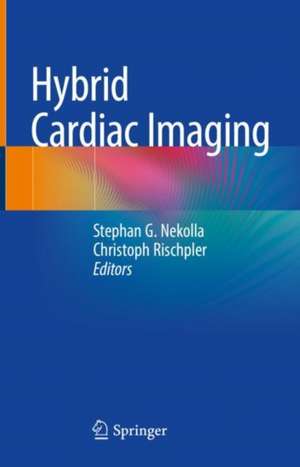Hybrid Cardiac Imaging
Editat de Stephan G. Nekolla, Christoph Rischpleren Limba Engleză Hardback – 31 oct 2021
| Toate formatele și edițiile | Preț | Express |
|---|---|---|
| Paperback (1) | 717.00 lei 6-8 săpt. | |
| Springer International Publishing – noi 2022 | 717.00 lei 6-8 săpt. | |
| Hardback (1) | 914.15 lei 38-44 zile | |
| Springer International Publishing – 31 oct 2021 | 914.15 lei 38-44 zile |
Preț: 914.15 lei
Preț vechi: 962.26 lei
-5% Nou
Puncte Express: 1371
Preț estimativ în valută:
174.94€ • 189.96$ • 146.95£
174.94€ • 189.96$ • 146.95£
Carte tipărită la comandă
Livrare economică 19-25 aprilie
Preluare comenzi: 021 569.72.76
Specificații
ISBN-13: 9783030831660
ISBN-10: 3030831663
Pagini: 309
Ilustrații: VIII, 309 p. 106 illus., 103 illus. in color.
Dimensiuni: 155 x 235 mm
Greutate: 0.68 kg
Ediția:1st ed. 2022
Editura: Springer International Publishing
Colecția Springer
Locul publicării:Cham, Switzerland
ISBN-10: 3030831663
Pagini: 309
Ilustrații: VIII, 309 p. 106 illus., 103 illus. in color.
Dimensiuni: 155 x 235 mm
Greutate: 0.68 kg
Ediția:1st ed. 2022
Editura: Springer International Publishing
Colecția Springer
Locul publicării:Cham, Switzerland
Cuprins
PART I Generic aspects of hybrid imaging._1 Hybrid imaging and health care economics._2 Hybrid imaging and radiation exposure._3 Industry perspective._4 Global/regional peculiarities._PART II SPECT/CT._5 Perfusion, Calcium Scoring, and CTA._6 Innervation/Intervention._7 Novel techniques: solid state detectors , dose reduction._PART III PET/CT._8 Perfusion, flow quantification, FFR._9 Viability._10 Inflammation._11 Novel CT technology._12 Novel PET tracers._PART IV PET/MR._12 Perfusion and viability._13 Inflammation._14 Novel MR technology
Notă biografică
Stephan G. Nekolla, PhD, FESC, is adjunct professor and the director of medical physics at the Department of Nuclear Medicine at Technische Universität München (Germany). Dr. Nekolla’s research fields are design, acquisition and analysis of PET, SPECT, MRI and CT studies, workflow considerations and quantification methods in clinical and pre-clinical studies. His primary focus is the optimal use of non-invasive imaging to understand the mechanism of disease in cardiology and oncology, their detection and therapy assessment. Especially the use of hybrid devices such as SPECT/CT, PET/CT, and PET/MRI their optimal use in cardiac and oncological imaging is of special relevance.
He is the author/co-author of > 260 peer-reviewed publications, book chapters and review articles (Publons H-index: 60, L-1857-2013).
Dr. Nekolla is chair of the working group medical physics of the German Society of Nuclear Medicine, ESMIT representative of the physics committee of theEuropean Society of Nuclear Medicine and member of the ESC/EACVI Nuclear Cardiology and Cardiac CT Section.
As part of the interdisciplinary imaging network at TU München, he is senior affiliated lecturer at the Chair of Computer Aided Medical Procedures & Augmented Reality (CAMPAR), member of the MunichHeartAlliance as well as member of the German Center of Cardiovascular Research (DZHK).
After studying physics at the University of Würzburg, Germany and his diploma thesis at the Institute of Biotechnology, he received his PhD at the Institute of Physics, University of Würzburg, before moving to Munich.
Christoph Rischpler, MD, is a Consultant at the Clinic of Nuclear Medicine, University Hospital Essen, University of Duisburg-Essen, Germany and holds a professorship for Nuclear Cardiology. He completed his residency at the Department of Nuclear Medicine, Klinikum rechts der Isar, Technische Universität München, Germany where he focused^110peer-reviewed publications, book chapters, and review articles and has an h-index of 28.
He is the author/co-author of > 260 peer-reviewed publications, book chapters and review articles (Publons H-index: 60, L-1857-2013).
Dr. Nekolla is chair of the working group medical physics of the German Society of Nuclear Medicine, ESMIT representative of the physics committee of theEuropean Society of Nuclear Medicine and member of the ESC/EACVI Nuclear Cardiology and Cardiac CT Section.
As part of the interdisciplinary imaging network at TU München, he is senior affiliated lecturer at the Chair of Computer Aided Medical Procedures & Augmented Reality (CAMPAR), member of the MunichHeartAlliance as well as member of the German Center of Cardiovascular Research (DZHK).
After studying physics at the University of Würzburg, Germany and his diploma thesis at the Institute of Biotechnology, he received his PhD at the Institute of Physics, University of Würzburg, before moving to Munich.
Christoph Rischpler, MD, is a Consultant at the Clinic of Nuclear Medicine, University Hospital Essen, University of Duisburg-Essen, Germany and holds a professorship for Nuclear Cardiology. He completed his residency at the Department of Nuclear Medicine, Klinikum rechts der Isar, Technische Universität München, Germany where he focused^110peer-reviewed publications, book chapters, and review articles and has an h-index of 28.
Textul de pe ultima copertă
This clinically oriented book provides an up-to-date review on the various hybrid imaging modalities that may be employed for the purpose of cardiac imaging. After discussion of generic aspects of hybrid imaging, SPECT/CT, PET/CT, and PET/MRI are each considered in depth. In addition, information is provided on upcoming technologies, such as dedicated so-called fast cardiac cameras (CZT detector technology) and novel probes and radiotracers. A wide variety of topics are addressed, including important technological aspects, possible applications, imaging protocols, peculiarities of the available modalities, radiation exposure, and dose reduction. Last but not least, an estimation of the cost efficiency of dedicated and hybrid imaging devices in cardiology is provided and possible scenarios with respect to health care economics are envisioned. Hybrid Cardiac Imaging will be of particular value for nuclear medicine specialists, cardiologists, and radiologists and will also be of interest to medical physicists, medical technicians, and cardiothoracic surgeons.
Caracteristici
Reviews all clinically relevant hybrid imaging modalities: SPECT/CT, PET/CT, and PET/MRI Discusses applications, instrumentation, protocols, peculiarities, and economic aspects Considers the role of novel imaging probes
